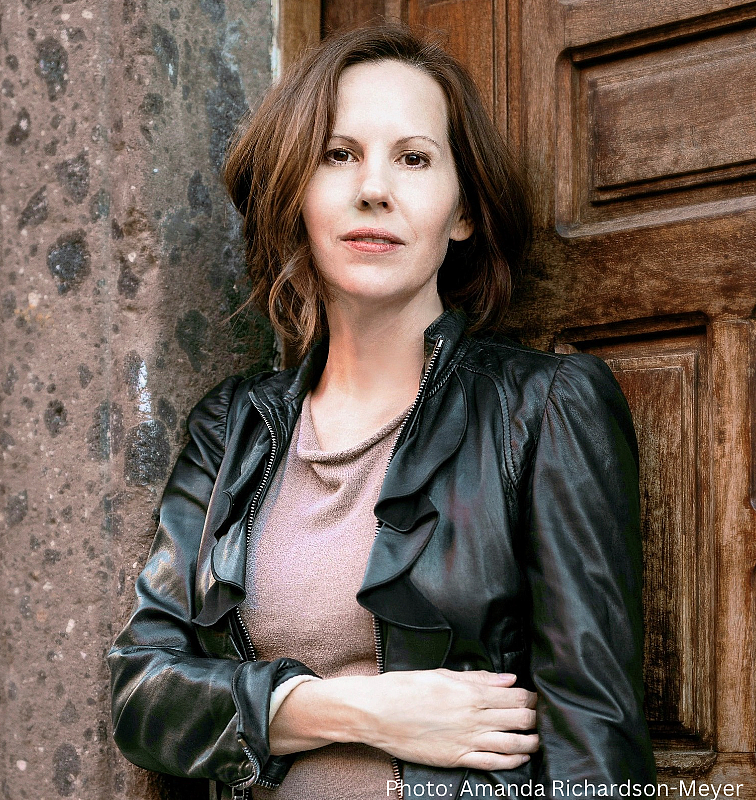
LibraryThing is pleased to sit down this month with bestselling author Danielle Trussoni, who made her debut in 2006 with Falling Through the Earth, a memoir chronicling her relationship with her father that was chosen as one of the Ten Best Books of the Year by The New York Times Book Review. Trussoni’s first novel, Angelology, was published four years later, going on to become a New York Times and international bestseller. It was translated into over thirty languages, and was followed in 2013 by a sequel, Angelopolis, which was also a bestseller. Trussoni has also published a second memoir, The Fortress: A Love Story (2016), and a stand-alone novel, The Ancestor (2020), and writes a monthly horror column for the New York Times Book Review. The Puzzle Master, a thriller involving a brilliant puzzle maker and an ancient mystery, was published in 2023, and a sequel, The Puzzle Box, is due out shortly from Random House. Trussoni sat down with Abigail to answer some questions about this new book.
The Puzzle Box continues the story of puzzle maker Mike Brink, a savant who came to his abilities through a traumatic brain injury. How did the idea for this character and his adventures first come to you? Did you always know you wanted to write more about Mike, or did you find that you had more to tell, after finishing The Puzzle Master
The idea for this character didn’t arrive in a lightning flash. Mike Brink developed through slowly working backward from the puzzle that I wanted to be at the center of this novel. I had developed a puzzle that the character of Jesse Price, a woman who is in prison for 30 years for killing her boyfriend, draws. She hasn’t spoken to anyone for five years but creates a cipher. Mike Brink arrives to solve it. At first, Mike was just a regular puzzle solver. And then I began to research real people with extraordinary abilities and stumbled upon Savant Syndrome. He seemed like the perfect vehicle for solving complex and fun mysteries.
I always knew that I wanted to write more about Mike Brink. I feel that this character has an almost endless supply of fascinating angles to write about. I could see writing about him for a long time!
Your hero has Sudden Acquired Savant Syndrome. What does this mean, and what significance does it have, to the story you wish to tell?
Savant Syndrome is an actual disorder that has occurred only a handful of times (there are between 50-75 documented cases). It occurs when there is damage to the brain, and a kind of hyper plasticity occurs, allowing the person to develop startling mental abilities. Some people become incredibly good at playing music, for example. Other people develop an ability with languages. But Mike Brink develops an ability to see patterns, solve puzzles, and make order out of chaos. Once I began to read about this skill—it’s really a kind of superpower!—I knew that this ability would be perfect for a hero of a mystery novel.
The Puzzle Box involves the Japanese royal family, a puzzle created by Emperor Meiji, and a notable samurai family. What kind of research did you need to do to tell this story, and what were some of the most interesting things you learned, in the process?
First of all, I lived in Japan for over two years. That experience was in the back of my mind as I developed the characters and the story of this book. That said, as I wrote The Puzzle Box, I found I wanted to see the places that appear in the novel: the Imperial Palace in Tokyo, the puzzle box museum in Hakone, and the many locations in Kyoto. So, I went to Japan for two weeks in 2023 to do on the ground research at these locations.
The historical elements of the book, especially the storyline about the Emperor Meiji and the Empresses of Japan, were a different story. I read a lot about the Imperial family, their origins, the discussions and controversies surrounding succession. A big part of my process is to read as much as I can find about something in my work and then carve out the most striking details.
How do you come up with the central puzzles in your books? Are they wholly original creations, or are they taken from or inspired by known puzzles?
The ideas for the puzzles are completely original, and necessarily have to do with the story I’m trying to tell. Each of the puzzles in The Puzzle Master and The Puzzle Box act as gateways to information that helps move the story forward. So I start with story. Then, I speak with the REAL puzzle geniuses, who help me imagine what kind of puzzles are possible. I work with two constructors, Brendan Emmett Quigley and Wei-Hwa Huang, who have worked for The New York Times Games Page (Wei-Hwa is a four-time World Puzzle Champion). They are incredibly smart and really understand what I’m trying to accomplish with my storytelling. Because the puzzles are not just gimmicks or diversions: they are essential to the plot of the novel.
What is different about writing a sequel, when compared to the first book in a series? Were there particular writing or storytelling challenges, or aspects that you enjoyed?
The Puzzle Box is designed as a stand-alone novel and can be read without reading The Puzzle Master. Still, Mike Brink is the hero of both novels, and there are other characters and storylines that show up in both books. I loved being able to go back to characters that I’d already spent time with, and found that because they were familiar, I could go deeper into their minds and feelings. The complications of Mike Brink’s superpower are a challenge for him. How he lives with his gift—and how he can continue to solve puzzles and find happiness—is the primary question of this series.
What can we expect next from you? Do you think you’ll write more about Mike? Are there any other writing projects you are working on?
I hope to write more books in this series, and of course Mike would be returning. I always have three or four novels on the back burner, and sometimes it’s hard for me to know which one will be the next to be written. Sometimes I need to wait and see.
Tell us about your library. What’s on your own shelves?
I am a lover of hardcover books, and so my shelves are packed with contemporary fiction in hardcover. I live in San Miguel de Allende Mexico, and it isn’t easy to get new books, but I’ve managed to find a way!
What have you been reading lately, and what would you recommend to other readers?
I used to write a book column for The New York Times Book Review, and a lot of my reading was for the column. But since I stopped writing it last year, I have been reading for pleasure. I’m revisiting books I loved in my twenties—And Then There Were None by Agatha Christie, for example—and I’m reading contemporary thrillers such as The Winner by Teddy Wayne and Look in the Mirror by Catherine Steadman. I have Richard Price’s Lazarus Man, which is out in a few months, on my most anticipated list. There is never enough time to read everything I want, but what I’m reading is exactly what I love most in fiction: sharp, evocative prose that carries me through an engrossing, surprising story. Give me those two things and I’m hooked.
 ).
).

















































![Murtagh [Deluxe Edition]](https://pics.cdn.librarything.com//picsizes/91/29/91290eb36002c38597233443867435141514141_v5.jpg)
























































































































































